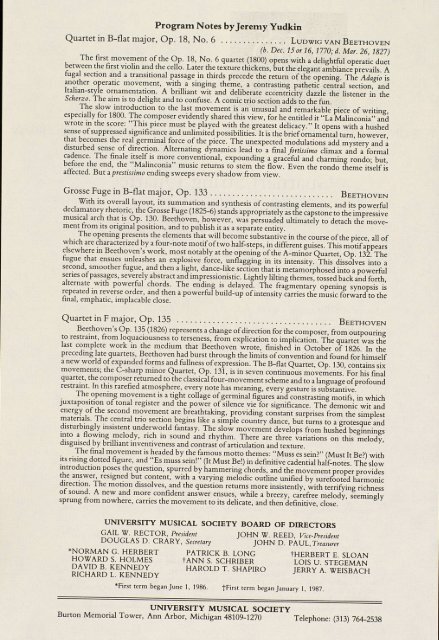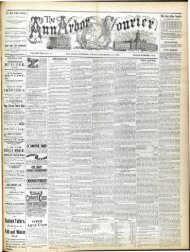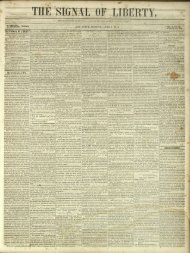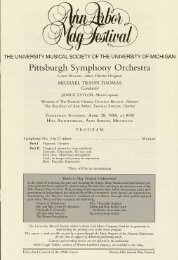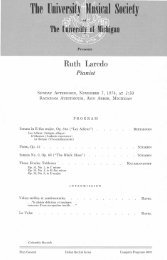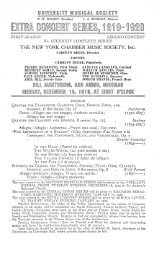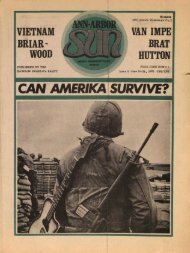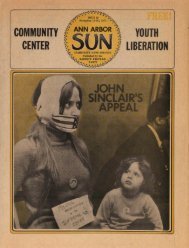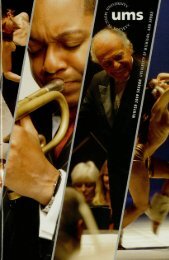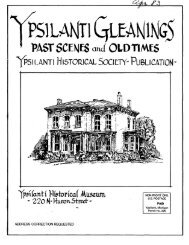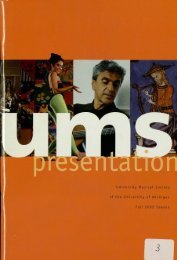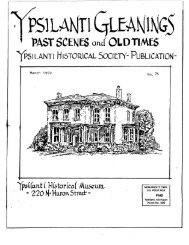You also want an ePaper? Increase the reach of your titles
YUMPU automatically turns print PDFs into web optimized ePapers that Google loves.
Program Notes by Jeremy Yudkin<br />
<strong>Quartet</strong> in B-flat major, Op. 18, No. 6 ............... LUDWIG VAN BEETHOVEN<br />
(b. Dec. 15 or 16, 1770; d. Mar. 26, 1827)<br />
The first movement of the Op. 18, No. 6 quartet (1800) opens with a delightful operatic duet<br />
between the first violin and the cello. Later the texture thickens, but the elegant ambiance prevails. A<br />
fugal section and a transitional passage in thirds precede the return of the opening. The Adagio is<br />
another operatic movement, with a singing theme, a contrasting pathetic central section, and<br />
Italian-style ornamentation. A brilliant wit and deliberate eccentricity dazzle the listener in the<br />
Scherzo. The aim is to delight and to confuse. A comic trio section adds to the fun.<br />
The slow introduction to the last movement is an unusual and remarkable piece of writing,<br />
especially for 1800. The composer evidently shared this view, for he entitled it "La Malinconia" and<br />
wrote in the score: "This piece must be played with the greatest delicacy." It opens with a hushed<br />
sense of suppressed significance and unlimited possibilities. It is the brief ornamental turn, however,<br />
that becomes the real germinal force of the piece. The unexpected modulations add mystery and a<br />
disturbed sense of direction. Alternating dynamics lead to a final fortissimo climax and a formal<br />
cadence. The finale itself is more conventional, expounding a graceful and charming rondo; but,<br />
before the end, the "Malinconia" music returns to stem the flow. Even the rondo theme itself is<br />
affected. But a prestissimo ending sweeps every shadow from view.<br />
Grosse Fuge in B-flat major, Op. 133 ............................ BEETHOVEN<br />
With its overall layout, its summation and synthesis of contrasting elements, and its powerful<br />
declamatory rhetoric, the Grosse Fuge (1825-6) stands appropriately as the capstone to the impressive<br />
musical arch that is Op. 130. Beethoven, however, was persuaded ultimately to detach the move<br />
ment from its original position, and to publish it as a separate entity.<br />
The opening presents the elements that will become substantive in the course of the piece, all of<br />
which are characterized by a four-note motif of two half-steps, in different guises. This motif appears<br />
elsewhere in Beethoven's work, most notably at the opening of the A-minor <strong>Quartet</strong>, Op. 132. The<br />
fugue that ensues unleashes an explosive force, unflagging in its intensity. This dissolves into a<br />
second, smoother fugue, and then a light, dance-like section that is metamorphosed into a powerful<br />
series of passages, severely abstract and impressionistic. Lightly lilting themes, tossed back and forth,<br />
alternate with powerful chords. The ending is delayed. The fragmentary opening synopsis is<br />
repeated in reverse order, and then a powerful build-up of intensity carries the music forward to the<br />
final, emphatic, implacable close.<br />
<strong>Quartet</strong> in F major, Op. 135 ................................... BEETHOVEN<br />
Beethoven's Op. 135 (1826) represents a change of direction for the composer, from outpouring<br />
to restraint, from loquaciousness to terseness, from explication to implication. The quartet was the<br />
last complete work in the medium that Beethoven wrote, finished in October of 1826. In the<br />
preceding late quartets, Beethoven had burst through the limits of convention and found for himself<br />
a new world of expanded forms and fullness of expression. The B-flat <strong>Quartet</strong>, Op. 130, contains six<br />
movements; the C-sharp minor <strong>Quartet</strong>, Op. 131, is in seven continuous movements. For his final<br />
quartet, the composer returned to the classical four-movement scheme and to a language of profound<br />
restraint. In this rarefied atmosphere, every note has meaning, every gesture is substantive.<br />
The opening movement is a tight collage of germinal figures and constrasting motifs, in which<br />
juxtaposition of tonal register and the power of silence vie for significance. The demonic wit and<br />
energy of the second movement are breathtaking, providing constant surprises from the simplest<br />
materials. The central trio section begins like a simple country dance, but turns to a grotesque and<br />
disturbingly insistent underworld fantasy. The slow movement develops from hushed beginnings<br />
into a flowing melody, rich in sound and rhythm. There are three variations on this melody,<br />
disguised by brilliant inventiveness and contrast of articulation and texture.<br />
The final movement is headed by the famous motto themes: "Muss es sein?" (Must It Be?) with<br />
its rising dotted figure, and "Es muss sein!" (It Must Be!) in definitive cadential half-notes. The slow<br />
introduction poses the question, spurred by hammering chords, and the movement proper provides<br />
the answer, resigned but content, with a varying melodic outline unified by surefooted harmonic<br />
direction. The motion dissolves, and the question returns more insistently, with terrifying richness<br />
of sound. A new and more confident answer ensues, while a breezy, carefree melody, seemingly<br />
sprung from nowhere, carries the movement to its delicate, and then definitive, close.<br />
UNIVERSITY MUSICAL SOCIETY BOARD OF DIRECTORS<br />
GA1L W. RECTOR, President JOHN W. REED, Vice-President<br />
DOUGLAS D. CRARY, Secretary JOHN D. PAUL, Treasurer<br />
*NORMAN G. HERBERT PATRICK B. LONG tHERBERT E. SLOAN<br />
HOWARD S. HOLMES tANN S. SCHRIBER LOIS U. STEGEMAN<br />
DAVID B. KENNEDY HAROLD T. SHAPIRO JERRY A. WEISBACH<br />
RICHARD L. KENNEDY<br />
*First term began June 1, 1986. fFirst term began January 1, 1987.<br />
UNIVERSITY MUSICAL SOCIETY<br />
Burton Memorial Tower, Ann Arbor, Michigan 48109-1270 Telephone: (313) 764-2538


